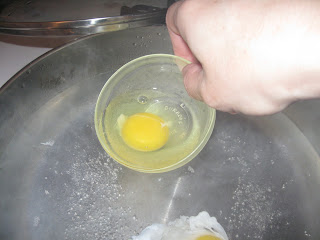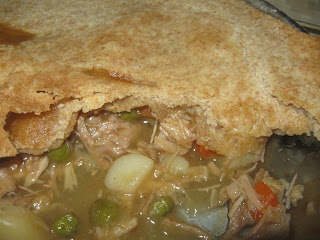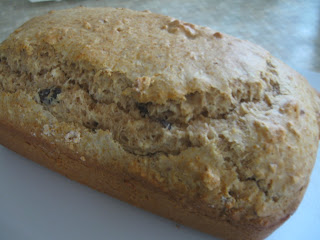 I love finding recipes that let me use meat as more of a condiment rather than the main item on my plate. It almost always means less calories and it's usually less expensive, too. Remember the big pork roast I cut up? Well the pork for this dish was sitting and waiting in my freezer until I had all the ingredients to put it together.
I love finding recipes that let me use meat as more of a condiment rather than the main item on my plate. It almost always means less calories and it's usually less expensive, too. Remember the big pork roast I cut up? Well the pork for this dish was sitting and waiting in my freezer until I had all the ingredients to put it together.Starting at least the day before, prepare your Creamy Slow-Cooker Beans. Soak 1 cup (I doubled this part of the recipe) of whatever kind of beans you like (I used pinto) overnight. The next morning, drain the beans and put them in the slow-cooker, along with a chopped up onion, a minced clove of garlic (optional) a tablespoon of bacon fat or butter and enough hot water to cover the beans. Cook on high for 4 hours or on low for about 6-8 hours until the beans are cooked through. Add salt to taste, reduce heat to keep warm until you are ready to serve.

When you are ready to prepare your meal, slice a poblano in half vertically; remove core, membrane, and seeds. Flatten halves skin-side up on a sprayed baking sheet or a foil-lined baking sheet. Place under the broiler until the skins blister and blacken, like above. Remove from the broiler, fold the foil over the pepper to form a tight packet; let rest 5 minutes.

Lift off and discard the skins; chop up the remaining flesh. Meanwhile, heat oil on medium high and add the pork, salt to taste, and stir often until browned, about 5 minutes.
 Leaving the liquid behind, remove the meat to a plate. To the pan, add onions, cook until it begins to brown, add the garlic, water and Worcestershire sauce and cook for a minute. Stir in the tomato and poblano. Cook down a bit, about 5 minutes. Return the meat to the skillet; cook 15-20 minutes until the sauce darkens and thickens, adding cilantro in the last 5 minutes.
Leaving the liquid behind, remove the meat to a plate. To the pan, add onions, cook until it begins to brown, add the garlic, water and Worcestershire sauce and cook for a minute. Stir in the tomato and poblano. Cook down a bit, about 5 minutes. Return the meat to the skillet; cook 15-20 minutes until the sauce darkens and thickens, adding cilantro in the last 5 minutes.Serve with Creamy Slow-Cooker Beans, and/or cooked rice, and a dollop of sour cream.
1 cup dry beans (your choice), soaked overnight
1 chopped onion
1 tablespoon bacon fat or butter
hot water
Drain soaked beans. Put beans, onion, bacon fat or butter, and hot water to cover into slow-cooker for 4 hours on high or 6-8 hours on low. Add salt to taste.
Pork and Poblano Skillet
1 poblano pepper
1 tablespoon oil
1 pound pork tenderloin or boneless pork loin, cubed
Salt to taste
1 onion, chopped
3 cloves garlic, chopped
2/3 cup water
2 tablespoons Worcestershire
15 ounces canned diced tomatoes
1/4 cup fresh chopped cilantro
Sour cream
Slice pepper in half vertically; remove core, membrane and seeds. Flatten halves skin-side up on foil on baking sheet. Place under broiler til skins blister and blacken. Remove from broiler, fold foil over the pepper to form a tight packet; let rest 5 minutes. Lift off and remove skins; chop up pepper.
Meanwhile, heat oil on medium high til shimmery in large skillet. Add pork, salt to taste, stir often til meat is browned, about 5 minutes. Leaving liquid behind, remove meat.
Add onions, cook til beginning to brown; add garlic, water, and Worcestershire. Stir in tomato and poblano. Cook down a bit about 5 minutes. Return meat to skillet; cook 15-20 minutes until sauce darkens and thickens, adding cilantro in last 5 minutes. Serve with beans and rice and a dollop of sour cream.
I'm posting this as a part of $5 Dinner Challenge and Tempt My Tummy Tuesday.



















.jpg)
.jpg)